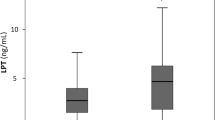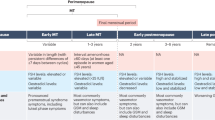Abstract
Postmenopausal women are at increased risk for progression of arteriosclerosis and hypertension. Recent cross-sectional evidence suggests that high normal circulating prolactin levels may accelerate vascular ageing in menopause. Postmenopausal women (n=201) were consecutively recruited from a Menopause Clinic and re-evaluated in at least one follow-up visit within the next 3 years. Baseline circulating prolactin levels were measured while both baseline and follow-up vascular and biochemical measurements were performed. Endothelial function was assessed by flow-mediated dilation (FMD), aortic stiffness by pulse-wave velocity (PWV) and arterial wave reflections by applanation tonometry. Baseline prolactin significantly correlated with lower FMD at follow-up (P=0.005). After multivariable adjustment for age, follow-up time, blood pressure (BP), body mass index, smoking and medication, this correlation remained significant (P=0.003). In addition, baseline circulating prolactin levels were independently associated with changes in mean BP (β=0.131, P=0.021), peripheral diastolic BP (β=0.169, P=0.004) and new-onset hypertension (OR=1.235, P=0.001). Owing to significant interaction between baseline prolactin and age for changes in PWV over time (P=0.036), a subgroup analysis based on median age was performed. This analysis revealed that in women younger than 55 years, prolactin was an independent predictor of changes in PWV over time (P=0.008). In conclusion, high normal circulating prolactin levels predict changes in haemodynamic indices and worsening endothelial function in healthy postmenopausal women. Particularly in young postmenopausal women, prolactin predicts accelerated arterial stiffening.
This is a preview of subscription content, access via your institution
Access options
Subscribe to this journal
Receive 12 digital issues and online access to articles
$119.00 per year
only $9.92 per issue
Buy this article
- Purchase on Springer Link
- Instant access to full article PDF
Prices may be subject to local taxes which are calculated during checkout

Similar content being viewed by others
References
Macias H, Hinck L . Mammary gland development. Wiley Interdiscip Rev Dev Biol 2012; 1 (4): 533–557.
Leanos-Miranda A, Marquez-Acosta J, Cardenas-Mondragon GM, Chinolla-Arellano ZL, Rivera-Leanos R, Bermejo-Huerta S et al. Urinary prolactin as a reliable marker for preeclampsia, its severity, and the occurrence of adverse pregnancy outcomes. J Clin Endocrinol Metab 2008; 93 (7): 2492–2499.
Georgiopoulos GA, Stamatelopoulos KS, Lambrinoudaki I, Lykka M, Kyrkou K, Rizos D et al. Prolactin and preclinical atherosclerosis in menopausal women with cardiovascular risk factors. Hypertension 2009; 54 (1): 98–105.
Yavuz D, Deyneli O, Akpinar I, Yildiz E, Gozu H, Sezgin O et al. Endothelial function, insulin sensitivity and inflammatory markers in hyperprolactinemic pre-menopausal women. Eur J Endocrinol 2003; 149 (3): 187–193.
Stamatelopoulos KS, Georgiopoulos GA, Sfikakis PP, Kollias G, Manios E, Mantzou E et al. Pilot study of circulating prolactin levels and endothelial function in men with hypertension. Am J Hypertens 2011; 24 (5): 569–573.
Therkelsen KE, Abraham TM, Pedley A, Massaro JM, Sutherland P, Hoffmann U et al. Association between prolactin and incidence of cardiovascular risk factors in the Framingham Heart Study. J Am Heart Assoc 2016; 5 (2): e002640.
Haring R, Volzke H, Vasan RS, Felix SB, Nauck M, Dorr M et al. Sex-specific associations of serum prolactin concentrations with cardiac remodeling: longitudinal results from the Study of Health Pomerania (SHIP). Atherosclerosis 2012; 221 (2): 570–576.
Ros S, Carrero JJ . Endocrine alterations and cardiovascular risk in CKD: is there a link? Nefrologia 2013; 33 (2): 181–187.
Parissis JT, Farmakis D, Fountoulaki K, Rigas A, Nikolaou M, Paraskevaidis IA et al. Clinical and neurohormonal correlates and prognostic value of serum prolactin levels in patients with chronic heart failure. Eur J Heart Fail 2013; 15 (10): 1122–1130.
Haring R, Friedrich N, Volzke H, Vasan RS, Felix SB, Dorr M et al. Positive association of serum prolactin concentrations with all-cause and cardiovascular mortality. Eur Heart J 2014; 35 (18): 1215–1221.
Carrero JJ, Kyriazis J, Sonmez A, Tzanakis I, Qureshi AR, Stenvinkel P et al. Prolactin levels, endothelial dysfunction, and the risk of cardiovascular events and mortality in patients with CKD. Clin J Am Soc Nephrol 2012; 7 (2): 207–215.
Horseman ND, Gregerson KA . Prolactin actions. J Mol Endocrinol 2014; 52 (1): R95–R106.
Wallaschofski H, Kobsar A, Sokolova O, Siegemund A, Stepan H, Faber R et al. Differences in platelet activation by prolactin and leptin. Horm Metab Res 2004; 36 (7): 453–457.
Sauro MD, Zorn NE . Prolactin induces proliferation of vascular smooth muscle cells through a protein kinase C-dependent mechanism. J Cell Physiol 1991; 148 (1): 133–138.
Arslan MS, Topaloglu O, Sahin M, Tutal E, Gungunes A, Cakir E et al. Preclinical atherosclerosis in patients with prolactinoma. Endocr Pract 2014; 20 (5): 447–451.
Reuwer AQ, van Eijk M, Houttuijn-Bloemendaal FM, van der Loos CM, Claessen N, Teeling P et al. The prolactin receptor is expressed in macrophages within human carotid atherosclerotic plaques: a role for prolactin in atherogenesis? J Endocrinol 2011; 208 (2): 107–117.
Friedrich N, Schneider HJ, Spielhagen C, Markus MR, Haring R, Grabe HJ et al. The association of serum prolactin concentration with inflammatory biomarkers—cross-sectional findings from the population-based Study of Health in Pomerania. Clin Endocrinol (Oxf) 2011; 75 (4): 561–566.
Manku MS, Horrobin DF, Zinner H, Karmazyn M, Morgan RO, Ally AI et al. Dopamine enhances the action of prolactin on rat blood vessels. Implications for dopamine effects on plasma prolactin. Endocrinology 1977; 101 (4): 1343–1345.
Yanes LL, Reckelhoff JF . Postmenopausal hypertension. Am J Hypertens 2011; 24 (7): 740–749.
Zhang L, Curhan GC, Forman JP . Plasma prolactin level and risk of incident hypertension in postmenopausal women. J Hypertens 2010; 28 (7): 1400–1405.
Brandes RP . Endothelial dysfunction and hypertension. Hypertension 2014; 64 (5): 924–928.
Kaess BM, Rong J, Larson MG, Hamburg NM, Vita JA, Levy D et al. Aortic stiffness, blood pressure progression, and incident hypertension. JAMA 2012; 308 (9): 875–881.
Gungor O, Kircelli F, Voroneanu L, Covic A, Ok E . Hormones and arterial stiffness in patients with chronic kidney disease. J Atheroscler Thromb 2013; 20 (9): 698–707.
Georgiopoulos GA, Lambrinoudaki I, Athanasouli F, Armeni E, Rizos D, Kazani M et al. Free androgen index as a predictor of blood pressure progression and accelerated vascular aging in menopause. Atherosclerosis 2016; 247: 177–183.
Benetos A, Adamopoulos C, Bureau JM, Temmar M, Labat C, Bean K et al. Determinants of accelerated progression of arterial stiffness in normotensive subjects and in treated hypertensive subjects over a 6-year period. Circulation 2002; 105 (10): 1202–1207.
Mancia G, Fagard R, Narkiewicz K, Redon J, Zanchetti A, Bohm M et al. ESH/ESC guidelines for the management of arterial hypertension: the Task Force for the Management of Arterial Hypertension of the European Society of Hypertension (ESH) and of the European Society of Cardiology (ESC). Eur Heart J 2013; 34 (28): 2159–2219.
Le Moli R, Endert E, Fliers E, Mulder T, Prummel MF, Romijn JA et al. Establishment of reference values for endocrine tests. II: HyperprolactinemiaNeth J Med 1999; 55 (2): 71–75.
Creatsa M, Armeni E, Stamatelopoulos K, Rizos D, Georgiopoulos G, Kazani M et al. Circulating androgen levels are associated with subclinical atherosclerosis and arterial stiffness in healthy recently menopausal women. Metabolism 2012; 61 (2): 193–201.
Goliasch G, Kleber ME, Richter B, Plischke M, Hoke M, Haschemi A et al. Routinely available biomarkers improve prediction of long-term mortality in stable coronary artery disease: the Vienna and Ludwigshafen Coronary Artery Disease (VILCAD) risk score. Eur Heart J 2012; 33 (18): 2282–2289.
Franklin SS, Gustin Wt, Wong ND, Larson MG, Weber MA, Kannel WB et al. Hemodynamic patterns of age-related changes in blood pressure. The Framingham Heart Study. Circulation 1997; 96 (1): 308–315.
Safar ME, Balkau B, Lange C, Protogerou AD, Czernichow S, Blacher J et al. Hypertension and vascular dynamics in men and women with metabolic syndrome. J Am Coll Cardiol 2013; 61 (1): 12–19.
Sabovic M, Safar ME, Blacher J . Is there any additional prognostic value of central blood pressure wave forms beyond peripheral blood pressure? Curr Pharm Des 2009; 15 (3): 254–266.
Laurent S, Briet M, Boutouyrie P . Large and small artery cross-talk and recent morbidity-mortality trials in hypertension. Hypertension 2009; 54 (2): 388–392.
Yannoutsos A, Levy BI, Safar ME, Slama G, Blacher J . Pathophysiology of hypertension: interactions between macro and microvascular alterations through endothelial dysfunction. J Hypertens 2014; 32 (2): 216–224.
Tousoulis D, Psarros C, Demosthenous M, Patel R, Antoniades C, Stefanadis C . Innate and adaptive inflammation as a therapeutic target in vascular disease: the emerging role of statins. J Am Coll Cardiol 2014; 63 (23): 2491–2502.
Acknowledgements
We thank Mrs Marina Karakitsou for performing all vascular studies.
Author information
Authors and Affiliations
Corresponding author
Ethics declarations
Competing interests
The authors declare no conflict of interest.
Rights and permissions
About this article
Cite this article
Georgiopoulos, G., Lambrinoudaki, I., Athanasouli, F. et al. Prolactin as a predictor of endothelial dysfunction and arterial stiffness progression in menopause. J Hum Hypertens 31, 520–524 (2017). https://doi.org/10.1038/jhh.2017.15
Received:
Revised:
Accepted:
Published:
Issue Date:
DOI: https://doi.org/10.1038/jhh.2017.15
This article is cited by
-
Vascular hemodynamics and blood pressure differences between young and older women
Clinical Hypertension (2021)
-
Kinetics of Postpartum Mesenteric Artery Structure and Function Relative to Pregnancy and Lactation in Mice
Reproductive Sciences (2021)
-
Sex-specific differences in hypertension and associated cardiovascular disease
Nature Reviews Nephrology (2018)



